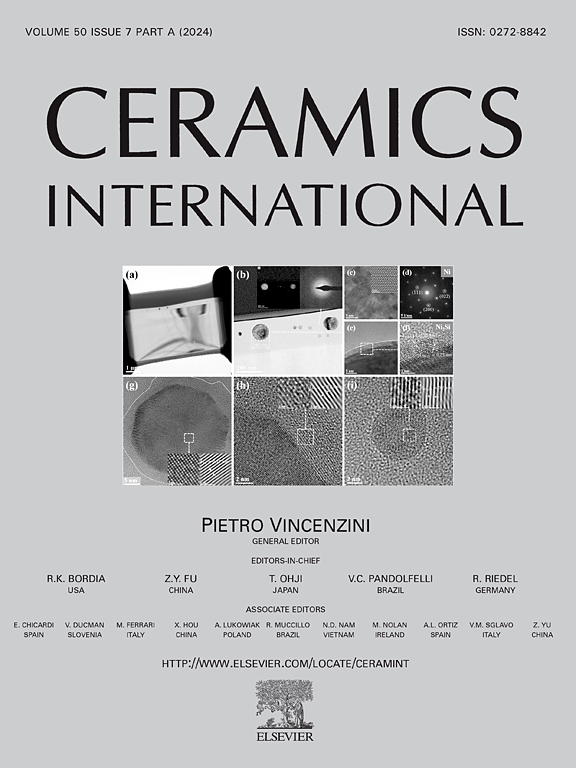Effect of alumina rich MgAl2O4 spinel on synthesis of MgO-CaZrO3 through solid-state sintering
IF 5.6
2区 材料科学
Q1 MATERIALS SCIENCE, CERAMICS
引用次数: 0
Abstract
Spinel-bonded MgO-CaZrO3 refractory bricks made up of sintered dolomite dust (CaO.MgO) generated from dolomite department, monoclinic zirconia (m-ZrO2) and sea water magnesia (MgO) has been synthesized. Two types of alumina rich magnesia alumina spinel (MgAl2O4) has been used in different proportions to study better bond formation between MgO and CaZrO3 grains enhancing the solid-state sintering. Different characterization in terms of structural integrity and refractoriness evaluation were suggested stoichiometric MgAl2O4 spinel (AR 78) has given the better densification of the MgO-CaZrO3 refractory over Al2O3 rich spinel. XRD study indicating phase evolution analysis has revealed that there is no free calcium oxide (CaO) or free zirconia (ZrO2) in phases of the sintered CaZrO3 grains. The developed CaZrO3 grains have large amount of micro fine pores (86 %) which help in improving the spalling resistance of the refractory aggregates. Addition of ultrafine spinel in MgO-CaZrO3 refractories has successfully improved the bond strength between MgO and CaZrO3.
富氧化铝MgAl2O4尖晶石对固相烧结合成氧化镁- cazro3的影响
以白云岩系生成的烧结白云石粉尘(CaO.MgO)、单斜氧化锆(m-ZrO2)和海水氧化镁(MgO)为原料,合成了尖晶石粘结型镁- cazro3耐火砖。采用两种不同比例的富铝镁铝尖晶石(MgAl2O4),研究了MgO与CaZrO3晶粒之间更好的结合,增强了烧结性能。在结构完整性和耐火度评价方面的不同表征表明,化学计量MgAl2O4尖晶石(ar78)比富Al2O3尖晶石具有更好的MgO-CaZrO3耐火材料致密性。XRD研究表明,烧结后的CaZrO3晶粒相中不存在游离氧化钙(CaO)和游离氧化锆(ZrO2)。发育的CaZrO3晶粒具有大量的微细孔(86%),有利于提高耐火材料集料的抗剥落性能。在MgO-CaZrO3耐火材料中加入超细尖晶石,成功地提高了MgO与CaZrO3的结合强度。
本文章由计算机程序翻译,如有差异,请以英文原文为准。
求助全文
约1分钟内获得全文
求助全文
来源期刊

Ceramics International
工程技术-材料科学:硅酸盐
CiteScore
9.40
自引率
15.40%
发文量
4558
审稿时长
25 days
期刊介绍:
Ceramics International covers the science of advanced ceramic materials. The journal encourages contributions that demonstrate how an understanding of the basic chemical and physical phenomena may direct materials design and stimulate ideas for new or improved processing techniques, in order to obtain materials with desired structural features and properties.
Ceramics International covers oxide and non-oxide ceramics, functional glasses, glass ceramics, amorphous inorganic non-metallic materials (and their combinations with metal and organic materials), in the form of particulates, dense or porous bodies, thin/thick films and laminated, graded and composite structures. Process related topics such as ceramic-ceramic joints or joining ceramics with dissimilar materials, as well as surface finishing and conditioning are also covered. Besides traditional processing techniques, manufacturing routes of interest include innovative procedures benefiting from externally applied stresses, electromagnetic fields and energetic beams, as well as top-down and self-assembly nanotechnology approaches. In addition, the journal welcomes submissions on bio-inspired and bio-enabled materials designs, experimentally validated multi scale modelling and simulation for materials design, and the use of the most advanced chemical and physical characterization techniques of structure, properties and behaviour.
Technologically relevant low-dimensional systems are a particular focus of Ceramics International. These include 0, 1 and 2-D nanomaterials (also covering CNTs, graphene and related materials, and diamond-like carbons), their nanocomposites, as well as nano-hybrids and hierarchical multifunctional nanostructures that might integrate molecular, biological and electronic components.
 求助内容:
求助内容: 应助结果提醒方式:
应助结果提醒方式:


